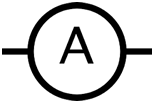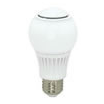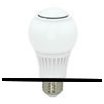TheLEDLight.com - What IS ... LED Definitions
These definitions have been written in a form that is easy to understand and only as they relate to LEDs. We hope that you will find these definitions easy to apply towards any LED product described on our website and understand what we have stated for those products.

Ambient
The surrounding light level in a given area. It is also the temperature in which a LED light source is expected to operate within. Referring to light, it is the light given off by the sun, moon, other light fixtures nearby or even within the same space.

Amp, Amperage, Milliamps
Amp is the basic unit of electric current adopted under the System International d'Unites. A typical household circuit carries 15 to 50 amps. Amperage is the strength of an electrical current measured in amperes. The higher the amperage number the higher the ability to place more devices on a circuit that will be driven by that amperage. mA stands for milliamps. 1000mA equals 1 amp.

Bulb
Is not a LED. A bulb is a light bulb, an MR17 or E27 base light bulb. A LED light bulb is a finished product that has the LEDs installed, electrical components installed and is ready to be used by the consumer. A LED light bulb is screwed in place, twisted and locked in place, pressed into sockets or contact terminals.

Bulb Base
The part of the bulb that is used to set it into place and to make contact with electricity. There are many types and sizes. Most common are E27/E27, USA and European standard household size, or medium base as it often is called. The 26 or 27 equates to the diameter measurement in millimeters of the threads of a screw in base bulb. This type of bulb includes the PAR20, PAR30 and PAR28 types. There are MR16 and MR11 type base LED bulbs as well as GU10's. There are also E12 candelabra base LED light bulbs

Chromaticity
Chromaticity tells you what the lamp itself or a neutral surface illuminated by a lamp will look like. Chromaticity sets the tone or atmosphere of a room: warm, cool or something in between. Sometimes called color temperature, it is measured in Kelvin. It can also be defined by using x and y coordinated against a standard chromaticity scale developed by the Commission Internationale de l'clairage (CIE).

CRI - Color Rendering Index
Also CCT or Correlated Color Temperature. It is a measure of the quality of light. A measurement of the amount of color shift that objects undergo when lighted by a light source as compared with the color of those same objects when seen under a reference light source of comparable color temperature. Higher CRI equates to sharper, crisper, more natural colored pictures while at the same time, reducing glare.
Color Temperature or CCT
A measure of the color of a light source relative to a black body at a particular temperature expressed in degrees Kelvin (K). Incandescent lights have a low color temperature (approx. 2800K) and have a red-yellowish tone. Warm white LED Lamps have a color temperature between 2700-3500K. Lamps rated between 5000K and 6000K are viewed as white, while lamps above 6000K tend to have a blue cast.

Dimmer
12 VDC dimmers are used with LED lights powered by 12 VDC. PWM built in as is an on/off switch. These dimmers are installed in between the power supply output and the fixture input. Customers also have the option of using a dimmable magnetic transformer in conjunction with a 120VAC standard dimmer. Many LED fixtures are on the market today that are able to be dimmed directly at 120 VAC.

Full Spectrum
A light bulb or lamp that produces a light spectrum that covers the entire range of visible light (400-700nM) without gaps in its spectral output. White LEDs are inherently a full spectrum light source.

Footcandles
The unit is defined as the amount of illumination the inside surface of an imaginary 1 foot radius sphere would be receiving if there were a uniform point source of one candela in the exact center of the sphere. Basically, the amount of light that a single candle would provide to a 1 foot radius sphere.


LED
LED stands for light emitting diode. LEDs are a solid state device and do not require heating of a filament to create light. Rather, electricity is passed through a chemical compound that is excited and generates light. LEDs are not bulbs or lamps in the true sense of the word and application. LEDs require a lot of work to make them ready to be used by the consumer. They are placed on a circuit board or other material that allows electricity to pass through at a specific voltage and current and with components required to operate them at specific voltages. The LED shown on the left is a first generation 3mm LED. See SMD LED definition below.

LED Bars
Refers to a solid strip of material on which LEDs have been soldered along with resistors and other components that a specific product requires to make them operate at the stated operating voltage. The bars are usually an enclosed strip of LEDs. Enclosures are plastic, aluminum or metal composites with various types of lens/covers.

LED Cluster or Array
A group of LEDs set in a square, rectangular or linear pattern and formatted to be operated at a specific voltage. They will always include wires called leads. One is negative, the other positive. In RGB products, there are four wires - red, blue, green and common.

Kelvin Color Temperature
A measure of the color of a light source relative to a black body at a particular temperature expressed in degrees Kelvin (K). Incandescent lights have a low color temperature (approx. 2800K) and have a red-yellowish tone. Warm white LED Lamps have a color temperature between 2700-3500K. Lamps rated between 5000K and 6000K are viewed as white, while lamps above 6000K tend to have a blue cast.
LED Drivers
LED drivers are current control devices that replace the need for resistors. LED drivers respond to the changing input voltage while maintaining a constant amount of current (output power) to the LED as its electrical properties change with temperature

LED Lighting
A general term used by those who do not know the specific type or category of LED lighting they are after. LED lighting includes LED bulbs and fixtures, strips, clusters, fluorescent tube replacements and so forth.

LED Strips
LED strips are usually printed circuit boards with LEDs soldered to the board. The strips can be rigid or flexible and without any enclosure to protect the LED and circuit. Here is where our crown molding and aluminum channel come into play.


Low Voltage
With LEDs, that means 12-48 VDC as opposed to 110/120 VAC which is high voltage. With LEDs, low voltage is commonly either 12VDC or 24VDC. To run these low voltage lights, power will have to be sent to the light through a power supply/transformer/adapter that is hooked up to 110/120/240VAC power lines. The actual voltage reaching the light will be at 12 or 24 VDC.

Lumen Maintenance
How well a LED product is able to retain its intensity when compared to new. Typically, a high power SMD LED bulb will retain 70% of its intensity for 40,000-50,000 hours. That means a good quality LED bulb will run 8 hours a day for 13 years at 70% of its new condition.

Lumens and Lux
The unit of luminous flux in the Internatonal System equal to the amount of light given out through a solid angle by a source of one candela intensity radiating equally in all directions. Used to measure light bulbs as stand alone light sources. Lighting fixtures are measured by lux output which is lumens per square meter. The higher the lux reading the more light the fixture is producing over a given area. Known as lumens per square meter

Max Rated Temperature
or Operating Temperature - is the ambient temperature where the LED light source is installed and should be maintained at. Operating a LED light source beyond the operating temperature will lower the LED's lifespan or kill it. Ambient temperature does NOT mean surface temperature. Often, the temperature of an object exposed to direct sun light can be much hotter than the surrounding temperature.

MCD or Millicandela
is used to rank/denote the brightness of a LED. 1000mcd is equal to 1 candela. The higher the mcd number, the brighter the light the LED emits.

UV A, B and C
UVA (380-315 nM) UVB (315-280nM) UVC (280 nM - ) UVA is called long wave or black light because it is visible to the human eye. Can cause skin irritation and fading of fabrics. UVB also called medium wave radiation can cause severe damage to the skin and human eye. UVC is also called short wave or germicidal for its ability to destroy even bacterial life forms. Extremely hazardous to all life forms due to its ability to cause immediate damage to cellular DNA.
nM or Nanometers
Used to measure the wavelength of light. The lower the wavelength the bluer and stronger the light source. Longer wavelengths above 600 nM fall into the infrared category which is colorless to our eyes. White LEDs have no specific wavelength. They are measured by the color of white against the chromaticity scale.

Operating Life
Usually refers to the number of hours a specific type of light source is expected to be operational. That usually means life after it loses some of it's initial rated output. LEDs have a higher operating life than other light sources.

PCB or Printed Circuit Board
PCB's are made from various materials including fiberglass, copper and aluminum. The PCB has an electrical circuit imprinted in silver etching. That circuit says how the LED will operate. The PCB is also the platform by which LEDs are employed in various applications. It can be rigid or flexible.

Power Supply
Transformer or Voltage Adapters apply to the electrical conversion of line voltage to low voltage that will then be applied directly to the LED light product. Power supplies are rated according to the current/amperage load capacity each will handle. It is an electrical or electromechanical device.

PWM or Pulse Width Modulation
Pulse width modulation with regards to LEDs means that the LED will be pulsed or strobed at a rate so fast that the eye will see the light as being constantly on when it fact it is not. This pulsing or turning the LED on and off lowers the potential heat stress on the chemical that makes the light, thus allowing the LED to perform longer than anticipated.


RGB
RGB stands for red, blue and green, the three primary colors that make white light and all other colors. It can be a pre-programmed 7 color automatically changing LED bar or strip that is non-adjustable. It also means a RGB color changing system which allows adjustment of color change frequency, strobing, chasing and other action modes by using a color controller.

SMD/SMT
A type of low profile LED that is surface mounted to a PCB. These type LEDs are very powerful. These have the most promise in delivering light levels and coloring that we are used to having.

SSL
Solid State Lighting. It does not use heating of a thin, fragile filament to create light. Rather, it uses electrical current passing through a chemical that will get excited and thus emit light.

Task Lighting
A LED light used to specifically light a particular area used for work or reading. Typically found in the form of a desk, floor or clamp on lamp, it can be a high powered LED light in any form.

View Angle
Also referred to as directivity or the directional pattern of a LED light beam. The expressed degree indicates the width of the light beam and also controls to some extent, the light intensity of a LED. View angles range from 8 to 360 degrees and are provided through the use of optics which are special lenses made to collimate light into a desired view angle.
Voltage
The rate at which energy is drawn from a source that produces a flow of electricity (amperage) in a circuit. The difference in electrical charge between two points in a circuit is expressed as volts. Volts is defined as a force equal to the difference of electric potential between two points on a conducting wire carrying a constant current of one ampere when the power dissipated between the points is one watt.

Voltage Regulator
A device which limits or controls and stabilizes the voltage being applied to a unit such as LED lights. Voltage regulators also take higher voltages than required and reduces it to the working voltage that makes a specific product run correctly. In many instances, lack of a voltage regulator will allow higher voltage than a product can work with and will cause irreparable damage.

Waterproof
Means that the LED product can be used in wet conditions. However, that varies from product to product. Refer to the IP Rating Chart. By no means does it mean submersible. As to product that will be cut in the field, it is up to the installer to be sure that any cuts are properly sealed.

Watts
The unit for measuring electrical power. It defines the rate of energy consumption by an electrical device when it is in operation. The energy cost of operating an electrical device is calculated as the wattage times the hours of use. In single phase circuits it is related to volts and amps by the formula: V x A x PF (power factor) = W. More and more we are getting away from stating brightness of a product by use of incandescent watts comparisons. Consumers now are used to lumen ratings which are more pertinent today.

